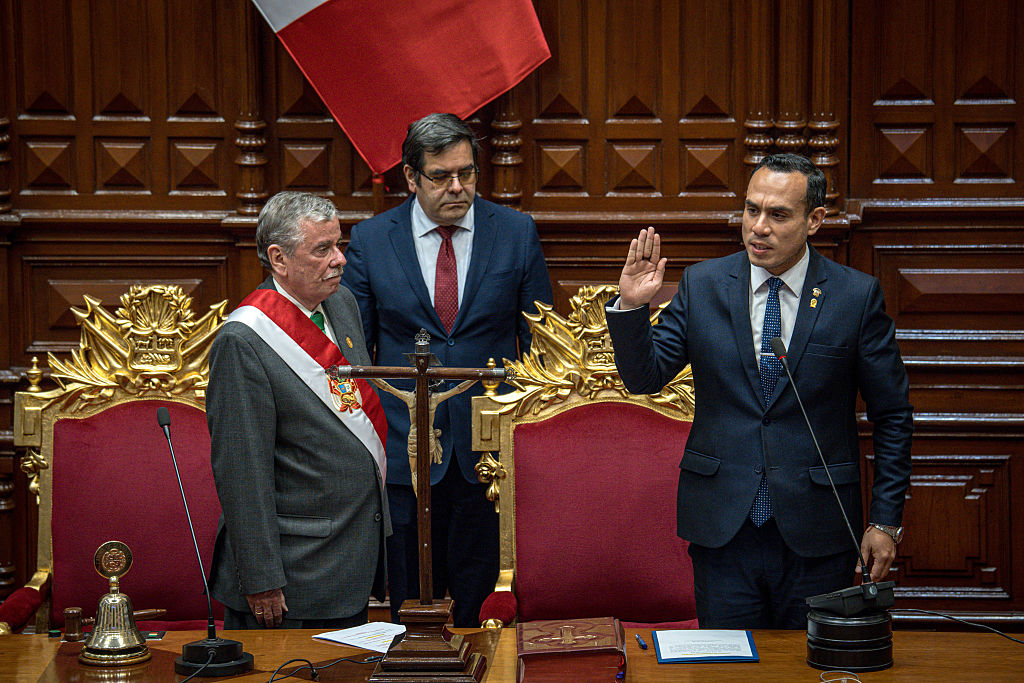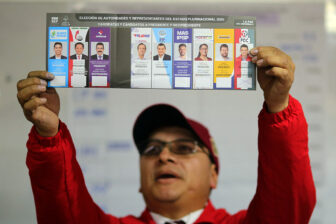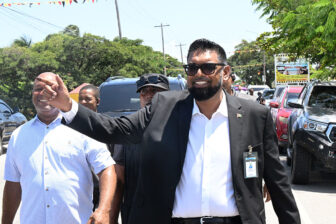Peru’s Congress voted unanimously to remove President Dina Boluarte from office in the early hours of Friday, October 10. Boluarte took office in 2022 after her predecessor, Pedro Castillo, was himself impeached.
The presidential crisis was preceded by a shooting in Lima, the nation’s capital, on Wednesday, when a man opened fire and injured five people at a concert of one of Peru’s most popular cumbia groups, the AP reported. The next day, lawmakers requested a vote to impeach Boluarte. Unlike eight prior attempts to remove her from the power, this one garnered support from almost all legislative factions, according to the AP. Boluarte did not appear before Congress to defend her presidency.
Boluarte, Peru’s first female president, was beset for much of her tenure by dismal approval ratings in the single digits, and in recent months a crime wave worsened her position. She was also investigated on multiple occasions on charges of illegal enrichment, including amid a high-profile scandal known as “Rolexgate.”
New President José Jerí, a 38-year-old conservative, had been the head of Congress. He is the country’s eighth president in 10 years and is set to serve out Boluarte’s term through July 28, 2026. Elections are scheduled for April.
AQ asked analysts to share their reactions and perspectives:

Alfredo E. Thorne
Principal director at Thorne & Associates. Thorne was Peru’s finance and economy minister from 2016-17, governor of Peru at the World Bank and the IDB, and an independent director of the Lima Stock Exchange.
Last night, Peru’s Congress impeached President Boluarte. This followed a sharp increase in insecurity and a deepening of the feeling that her government had not been attending to the population’s demands.
Two events triggered the impeachment: an urban transport strike on Tuesday that paralyzed Lima, and a shooting by extortionists at the concert of a highly popular band, Agua Marina, in an army base on Wednesday.
While these events triggered the impeachment, this political crisis had been brewing since Boluarte took office as president in December, 2022. Her term began with the protests in the south of Peru, where about 50 demonstrators died in clashes with police and the army. She proceeded to govern as a president disconnected from the population at large. She was investigated on allegations of acquiring expensive Rolex watches and other jewelry, secretly performing plastic surgery, and other offenses.
Born and raised in Chalhuanca, Apurímac, a poor city in the south of Peru, one would have expected greater contact with the low-income population. Instead, Boluarte may become known to history as Peru’s least popular president of all time; in the latest poll she garnered only 2% support.
Although the Constitution mandates that the president has the right to defend herself during a congressional impeachment proceeding, Boluarte opted not to attend. Congress elected Speaker José Jerí as the next president. Jerí becomes the eighth president to hold office in the last 10 years, a sign of the deep political crisis the country has endured of late.
Unfortunately, Boluarte leaves behind a highly divided country, and it won’t be easy for Jerí to pacify the nation. That this is happening six months ahead of the general elections due on April 12 next year, in which 39 political parties are competing, further increases uncertainty.
Although Peru has had positive experiences with interim governments, the stakes are high. While the economy performed well in the first half of year, growing 3.4% supported by high commodity prices, growth is expected to decelerate toward the latter part of 2025. Our forecast sees the national GDP growth averaging 2.7% this year and 2.6% in 2026.

Eduardo Ruiz
Analyst for the Andean Region at Control Risks
The unanimous vote in Congress to support the removal of President Dina Boluarte underscored not only her dwindling political backing within the legislature but also the strategic maneuvering of the political parties that once sustained her government. While the result exposes the depth of Boluarte’s isolation, it also reflects a calculated effort by Peru’s political elite to distance themselves from a deeply unpopular administration ahead of the 2026 presidential elections.
Until this week, Boluarte still enjoyed the support of influential political forces such as Keiko Fujimori’s Fuerza Popular. However, the party’s decision to withdraw its backing reveals a broader strategy aimed at avoiding electoral repercussions and preventing voters from associating them with what many perceive as a disastrous government. The move is a clear sign that political actors are already recalibrating their alliances as the electoral race gains momentum.
José Jerí, now appointed as Peru’s new president, faces the daunting task of ensuring a peaceful transition while addressing the country’s worsening security crisis. Extortion cases have risen by 25% in the first six months of 2025, illustrating the depth of the challenge. However, it is unlikely that Jerí will be able to implement significant security measures in the short term. With less than a year before the elections, his government will prioritize Cabinet appointments and administrative restructuring, steps that, while necessary, will consume much of the limited time available to design and execute an effective anti-crime strategy.
In addition, the new president is unlikely to gain broad public support, as he is seen as part of the traditional political elite and faces several accusations, including sexual abuse, corruption, and disobedience. As a result, widespread social unrest is expected to persist. Discontent continues to grow among various sectors affected by rising crime rates, many of which have expressed willingness to join the ongoing demonstrations led by Generation Z activists and transport unions.
Despite the political turbulence, it is highly unlikely that the electoral calendar will change. The presidential elections are scheduled for April 2026, and most parties have already begun selecting their candidates. Advancing the elections would disrupt these internal processes, leaving little time for alliance-building, campaigning, and voter mobilization.
Peru thus enters a period of fragile stability, marked by political realignment, social unrest, and intensifying organized crime activity. The new administration will have limited capacity to bring about meaningful change before voters once again head to the polls.

Will Freeman
Fellow for Latin America Studies at the Council on Foreign Relations
Boluarte’s forced resignation shows the coalition really in charge—the factions in control of Congress—is running out of options. This coalition, summed up as the “four families” by Peruvian professor Rosa María Palacios—the Fujimoris, César Acuña, José Luna Gálvez, and the Cerrón family—has aggressively and effectively pursued a shared agenda over the past two years: curb judicial independence, transfer power from other branches to the legislature, and pass what Peruvians are calling “pro-crime laws” gutting law enforcement and catering to criminal interests.
This blatantly self-serving agenda is deeply unpopular among virtually all Peruvians, especially as its costs increasingly show up in daily life: emboldened extortion gangs, assassinations in broad daylight, and rampant illegal logging, mining, and drug trafficking. Boluarte—always servant to and hostage of this coalition—was an easy sacrifice to let off some steam. She may be the first Latin American president to be ousted directly as the result of the region’s ongoing organized crime surge (her non-response to a shooting at a Lima concert was the final straw).
But the public was and is angry with a larger political project, not just Boluarte. The question is: will it channel this anger into support for a challenger—hopefully democratic, but quite possibly autocratic—to the current coalition in April 2026 elections, or will opposition remain fragmented and diffuse?







